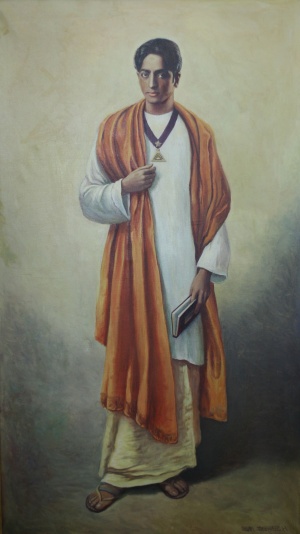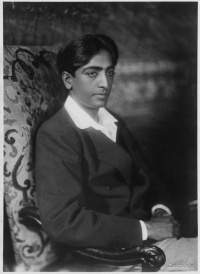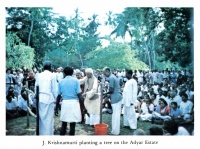Jiddu Krishnamurti: Difference between revisions
Pablo Sender (talk | contribs) No edit summary |
Pablo Sender (talk | contribs) No edit summary |
||
| Line 51: | Line 51: | ||
== Life-altering experiences == | == Life-altering experiences == | ||
Since 1914 Krishnamurti had been absorbed by more "mundane" pursuits, | Since 1914 Krishnamurti had been absorbed by more "mundane" pursuits, unsuccessfully trying to get to Oxford, Cambridge, and London University. He had lost much of his enthusiasm for the work of the Masters and his role in it. However, in 1920 his interest in [[Theosophy]] and the [[Order of the Star in the East]] slowly started to reawaken. On [[May 6]] he wrote to Lady Emily: | ||
<blockquote>Curiously all day I have been very dreamy, more dreamy than usual and in my heart there have been a continual thought of Lord Buddha. I was in such a state that I had to sit down and meditate. Think of me meditating. Extraordinary.<ref>Mary Lutyens, ''Krishnamurti: The Years of Awakening'' (New York: Farrar, Straus and Giroux, 1975), 119.</ref></blockquote> | |||
And in March 1921: | |||
<blockquote>I have been thinking a great deal about the Order & the T.S. ''mais surtout de moi-même''. I must find myself and then only can I help others. In fact, I must make the Old Gentleman come down & take some responsibility. Probably he wants to but finds that the body & mind is not spiritual enough & now I must waken them for 'his' habitation.<ref>Mary Lutyens, ''Krishnamurti: The Years of Awakening'' (New York: Farrar, Straus and Giroux, 1975), 127-128.</ref></blockquote> | |||
From this point on Krishnamurti started giving lectures and writing articles. | |||
== Death of his brother == | == Death of his brother == | ||
Revision as of 21:35, 14 May 2014

ARTICLE UNDER CONSTRUCTION
ARTICLE UNDER CONSTRUCTION
Jiddu Krishnamurti (May 11, 1895 – February 17, 1986) was an author and lecturer on spiritual and philosophical subjects who had a major impact on Twentieth Century thought. He was "discovered" as a child in India by Charles W. Leadbeater, who believed that the boy had the potential to become a great religious leader. Krishnamurti and his brother Nitya were educated by Theosophists at the Theosophical Society based in Adyar, Chennai,India. Adyar Theosophists established the Order of the Star in the East to promote the idea the Krishnamurti was the much-anticipated "World Leader" or Maitreya. Eventually Krishnamurti rejected the role and the organization, and taught that "Truth is a pathless land".
Krishnamurti was often referred to by his friends as "K".
Early years
Jiddu Krishnamurti was born was born a Brahmin on May 11 1895 in Madanapalle, Andhra Pradesh, near Madras in the south of India. He was the eight son and, in keeping with tradition, was named after Sri Krishna.
Although his father, Jiddu Narianiah, was educated at Madras University and worked for the British Administration, the standard of life of the family was not good. Only five or six of the eleven children of the family would survive childhood. When Krishnamurti was two years old he nearly died of malaria, and his mother, Jiddu Sanjeevamma, eventually died of it when he was only ten.
In 1907 his father was given a compulsory retirement. Having been a member of the Theosophical Society since 1882,[1] he eventually obtained a job at its International Headquarters in Adyar, Madras (now Channai).
"Discovery"
On January 23, 1909, the Jiddu family moved to Madras. In May of that year, Theosophical leader and clairvoyant C. W. Leadbeater runs into 13-year old Krishnamurti who was playing in the beach, and sees "the most wonderful aura he has ever seen, without a particle of selfishness". Although Theosophist and scholar Ernest Wood, who had tried to help him with his homework, considered him dim-witted, Leadbeater predicted that he would become a spiritual teacher and a great orator "much greater" than even Annie Besant. His Biographer Mary Luthyens wrote:
It could not have been Krishna's outward appearance that struck Leadbeater, for apart from his wonderful eyes, he was not at all prepossessing at that time. He was under-nourished, scrawny and dirty; his ribs showed through his skin and he had a persistent cough; his teeth were crooked and he wore his hair in the customary Brahmin fashion of South India, shaved in front to the crown and falling to below his knees in a pigtail at the back; moreover his vacant expression gave him an almost moronic look.[2]
Soon, C. W. Leadbeater started researching their past lives and become aware of their relationship with himself and the Masters. These accounts were published in articles in The Theosophist, the mystic name given to Krishnamurti being Alcyone. All these accounts were eventually published in the book Lives of Alcyone.
During this time a group of Theosophists began to take care of him and his younger brother, Nityananda. They nourished them physically, and taught them hygiene, yogic postures, breathing exercises, and sports. Eventually they also took care of their academic education.
Annie Besant, who was abroad on a tour, met them for the first time on November 27, 1909. On March 6, 1910 she became their legal guardian.
Initiations
C. W. Leadbeater reported that on the night of August 1, 1909, Master K.H. had put Krishnamurti on probation.
Then, Leadbeater started taken him every night in his astral body to the house of the Master to be instructed for fifteen minutes. The next morning Krishnamurti would write down what he remembered, and these notes were later published as the book At the Feet of the Master.
After only five months of probation he was accepted as a chela, and received his first initiation on January 11, 1910, while he was at Adyar.
The second initiation took place on the night of the full moon of May 1, 1912, while he was in Taormina, in Sicily, Italy.
World Teacher movement
On January 11, 1911, George Arundale formed The Order of the Rising Sun to draw together those in India who believed in the near coming of a great spiritual teacher and prepare public opinion to receive him. At the same time a quarterly magazine printed at Adyar called The Herald of the Star was started. A few months later Besant and Leadbeater made this into an international movement called The Order of the Star in the East, of which Krishnamurti was the head.
On December 28, 1911, when Krishnamurti was handling certificates to new members of the Order, the following happened, as reported by C. W. Leadbeater:
All at once the Hall was filled with tremendous power, which was so evidently flowing through Krishna[murti] that the next member fell at his feet, overwhelmed by this marvellous rush of force. I have never seen or felt anything in the least like it; it reminded one irresistibly of the rushing mighty wind and the outpouring of the Holy Ghost at Pentecost. The tension was enormous, and everyone in the room was most powerfully affected. It was exactly the kind of thing that we read about in the old scriptures, and think exaggerated; but here it was before us in the twentieth century. After that, each one prostrated himself as his turn came, many of them with tears pouring down their cheeks. The scene was indeed a memorable one, for the stream of devotees was remarkably representative in character. There were members from almost every country in Europe, from America and from all parts of India. . . .[3]
After this Annie Besant made public the fact that Krishnamurti's body had been chosen by Maitreya to serve as his vehicle.
Life-altering experiences
Since 1914 Krishnamurti had been absorbed by more "mundane" pursuits, unsuccessfully trying to get to Oxford, Cambridge, and London University. He had lost much of his enthusiasm for the work of the Masters and his role in it. However, in 1920 his interest in Theosophy and the Order of the Star in the East slowly started to reawaken. On May 6 he wrote to Lady Emily:
Curiously all day I have been very dreamy, more dreamy than usual and in my heart there have been a continual thought of Lord Buddha. I was in such a state that I had to sit down and meditate. Think of me meditating. Extraordinary.[4]
And in March 1921:
I have been thinking a great deal about the Order & the T.S. mais surtout de moi-même. I must find myself and then only can I help others. In fact, I must make the Old Gentleman come down & take some responsibility. Probably he wants to but finds that the body & mind is not spiritual enough & now I must waken them for 'his' habitation.[5]
From this point on Krishnamurti started giving lectures and writing articles.
Death of his brother
Rejection of World Teacher role
Speaking tours
Krishnamurti schools
Early in his career Krishnamurti showed a concern about education. In 1912, when he was only 17, he wrote the book Education as Service in which he described "the life of an ideal school where love rules and inspires, where the students grow into noble adolescents under the fostering care of teachers who feel the greatness of their vocation".[6]
Later years
Experiences with the Masters
During the early years Krishnamurti reported many times his experiences with the Masters on the astral plane. Below a list of some of them:
- For five months since August 1, 1909, he astrally visited the house of Master K. H. every night, while his body was asleep. There, he received instruction from the Master which would be written down in the morning, frequently in the presence of witnesses.[7]
- On December 31, 1909, he wrote to Annie Besant (then in Benares) an account of an astral visit to the Masters in which he was accepted as a disciple of Master K. H. He was at Adyar with C. W. Leadbeater.[8]
- He also wrote an account of his initiation on the astral plane which took place on January 11, 1910.[9]
- On June 12, 1911, while in a lecture Annie Besant was giving at the Sorbonne, he claimed to have seen "the Count there",[10] probably referring to the Mahatma known as the Count de Saint Germain.
- On June 27, 1911, while in England, he remembered going with George Arundale to the house of Master K.H., where the latter accepted the former as his chela. He received confirmation of this from C. W. Leadbeater, who was at Adyar.[11]
- In January, 1914, while at Taormina, Sicili, Krishamurti "suddenly looked up and said, 'The Lord Buddha is here'. His whole face changed completely and he rushed from the room. Soon he came back and told them that he had seen the Lord Buddha standing beside him."[12]
Teachings
Writings
Online resources
Audio
- Krishnamurti and Eastern Philosophy by Ravi Ravindra
- Krishnamurti on the Masters by Aryel Sanat
Additional resources
Notes
- ↑ Mary Lutyens, Krishnamurti: The Years of Awakening (New York: Farrar, Straus and Giroux, 1975), 6.
- ↑ Mary Lutyens, Krishnamurti: The Years of Awakening (New York: Farrar, Straus and Giroux, 1975), 21.
- ↑ Mary Lutyens, Krishnamurti: The Years of Awakening (New York: Farrar, Straus and Giroux, 1975), 55.
- ↑ Mary Lutyens, Krishnamurti: The Years of Awakening (New York: Farrar, Straus and Giroux, 1975), 119.
- ↑ Mary Lutyens, Krishnamurti: The Years of Awakening (New York: Farrar, Straus and Giroux, 1975), 127-128.
- ↑ Mary Lutyens, Krishnamurti: The Years of Awakening (New York: Farrar, Straus and Giroux, 1975), 59.
- ↑ Mary Lutyens, Krishnamurti: The Years of Awakening (New York: Farrar, Straus and Giroux, 1975), 28.
- ↑ Mary Lutyens, Krishnamurti: The Years of Awakening (New York: Farrar, Straus and Giroux, 1975), 33-34.
- ↑ Mary Lutyens, Krishnamurti: The Years of Awakening (New York: Farrar, Straus and Giroux, 1975), 35-38.
- ↑ Mary Lutyens, Krishnamurti: The Years of Awakening (New York: Farrar, Straus and Giroux, 1975), 51.
- ↑ Mary Lutyens, Krishnamurti: The Years of Awakening (New York: Farrar, Straus and Giroux, 1975), 51.
- ↑ Mary Lutyens, Krishnamurti: The Years of Awakening (New York: Farrar, Straus and Giroux, 1975), 81.


